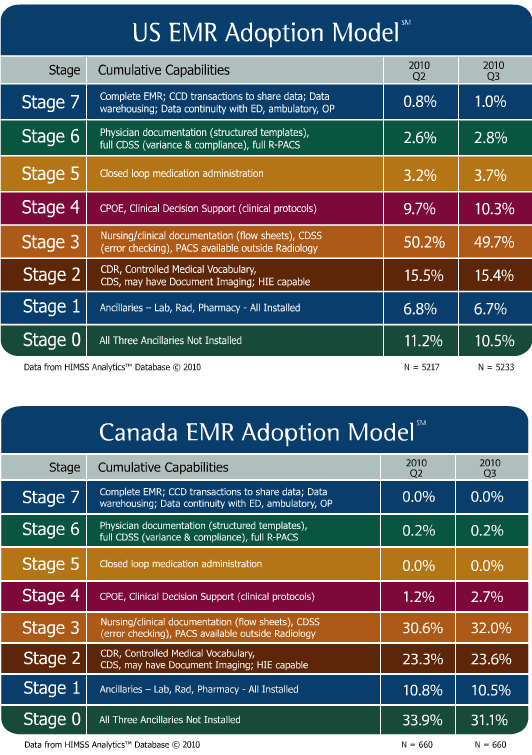While the theme of HIMSS 2013 may have been, “How Great Is Interoperability,” the effectiveness of the many facets of interoperability are only as good as the actionable value of the shared data. The clinical insights that should be enabled by Meaningful Use Stage 2+ are expected to drive market trends in myriad areas of the healthcare system: chronic disease management, targeted member interventions, quality measures. In order to assess organizational readiness to capitalize on the promise of Meaningful Use, HIMSS Analytics began measuring the implementation and adoption of EMR and clinical documentation using a maturity model called EMRAM.
But, in analytics terms, EMRAM’s results are simply targeted foundational reporting, answering the question, “WHAT happened with Meaningful Use EMR adoption criteria.” So, you’ve got your clinical data in an EMR. Now what are you able to DO with it?
In 2013, HIMSS Analytics is taking a broader approach with the introduction of a new Clinical Business Intelligence maturity model, creating a framework to benchmark participating providers’ analytics maturity level.
I’ve been fortunate to know James Gaston, Senior Director of HIMSS Analytics Clinical & Business Intelligence, for many years, going back to his days with Arkansas Blue Cross. His appreciation for BI initiatives is matched only by his enthusiasm for the first day of turkey hunting season. When I ran into him at TDWI’s BI World summit in Orlando in November, he acted like a kid on Christmas morning, telling me about the brave new world of clinical data management that he was about to tackle. The excitement continued to build in the months leading up to HIMSS. James was practically glowing when we spoke about the upcoming C&BI Maturity Model release.
“Our customers are interested in not just understanding how to deploy IT applications, but how effectively they’re using those applications to support clinical business intelligence, as well as analytical pursuits,” James said. “So, HIMSS Analytics partnered with IIA to create and present a Clinical & BI Maturity Model that helps healthcare organizations measure that level of effectiveness.”
Sarah Gates, the VP of Research for IIA (the International Institute of Analytics), elaborated. “The HIMSS Analytics C&BI Maturity Model leverages the Competing on Analytics DELTA model, developed by Tom Davenport, which measures not only how well you’re using data and technology, but how well you’re building an analytical organization.” There are 5 core competency measurements in the DELTA model that will inform the HIMSS Analytics C&BI analysis: Data, Enterprise, Leadership, Targets, and Analysts. The methodology is holistic, touching on the cultural aspects of the organization as well as the technical, allowing a longitudinal view of the organization’s analytics program. A yardstick value from 1-5 will be assigned to each respondent based on Davenport’s criteria for each core competency.
Although HIMSS Analytics will eventually offer Level 1-5 certification program for those organizations with observed results for analytics, James and Sarah agreed that it is not appropriate for every provider to reach for the Level 5 gold star. Per Sarah, “Healthcare is an industry just starting to discover analytics. We’re expecting to see lots of practitioners that are emerging in use of analytics, so we believe it (survey results) will be heavy on the lower end of the maturity scale. Data warehouse capabilities and staffing career paths for data analysts will be key differentiators for mature programs.” Not all providers have the resources – financial, human, and/or technical – to attain advanced analytics nirvana, and James wants to insure that these providers don’t feel as if they’ve “failed”; the goal is to baseline against the peer group, identify opportunities for improvement, and focus on what is possible for each individual organization, working within their constraints.
What can we expect to see at next year’s C&BI survey results presentation? James said, “We want to be able to talk about benchmarking the industry as a whole, helping healthcare find its way with clinical business intelligence and begin to understand how important it is, and where opportunities lie Everyone’s talking about clinical and BI – it is the opportunity to realize savings in healthcare, to use information to empower people to make better decisions.”
So, it’s up to you, providers and technology partners. You’ve implemented your EMR, achieved a high adoption rate across your organization’s core clinical processes, attested to Meaningful Use Stage 2, achieved Stage 7 on the HIMSS EMRAM scale, perhaps even participated in multi-HIE CCD medical records sharing with other provider networks. You’ve got the data in-house and availabe. It’s time to see how ready you are to rise to the analytics challenge and maximize your return on those EMR and HIE investments.
Attempt to beat your previous Doug Fridsma long jump.
Note: for the complete HIMSS 2013 Leadership Survey Results, please download PDF here.














